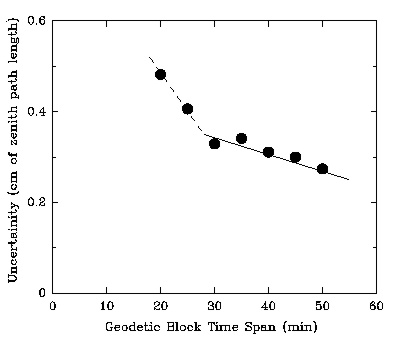
The ionosphere also adds a delay and the correlator model has no ionospheric term. Typically this zenith path delay is about 0.7 cm at 43 GHz and scales as the inverse-square of the frequency. An approximate correction for the ionosphere can be made using the VLBAUTIL procedure VLBATECR in AIPS.
We are using a program that tries large numbers of quasi-randomly generated geodetic blocks and finds nearly optimum blocks that can be inserted in observing schedules. A library of geodetic blocks can be found here. There is a block for start times every 10 minutes; the start times are given in Pie Town local sidereal time (PT_LST). Each block requires about 30 minutes of observing time on the VLBA. The files are named "geoblock_hhmm.out", where hhmm is the start time. These blocks assume an on-source observing time of one minute (DWELL=60).
Since these blocks observe sources down to low elevations, it is important that they start very close in time to the indicated PT_LST time. If you use these, be sure to check that the source elevations (listed in the files) are close to what the VLBA scheduling program (SCHED) gives!
The library of geodetic blocks used a list of ICRF "QSOs" which is needed by the VLBA SCHED program. These QSOs were selected to have more than 1000 ICRF observations, little source structure, and positions accurate to better than 1 mas. They generally work well at 8 GHz and higher observing frequencies. Each block has an associated file, eg, src_catalog_0610.out, which gives the source coordinates in SCHED format for the associated geoblock.

|
Accuracy of atmospheric zenith delays from VLBA observations of geodetic blocks as a function of time dedicated to the observations. The accuracies are based on simulations and assume multi-band delays with uncertainties of 3 cm of path length (0.1 nsec delay). For blocks shorter than about 25 minutes, it is hard to find a wide range of source elevations at all 10 VLBA stations, and the accuracy degrades rapidly. For blocks longer than 30 minutes the accuracy increases slowly as the inverse square-root of time. |
1) Apply a "manual phase-calibration", using a single QSO observation to all the others. This should be done for a scan that has strong signal at all stations.
2) Use FRING to solve for multi-band delays.
3) Solve for the atmospheric delays with DELZN or some other program
4) Apply the corrections with CLCOR.
We strongly recommend checking that this procedure works by re-FRING'ing after correction and resolving with DELZN. The new corrections should be very close to zero.